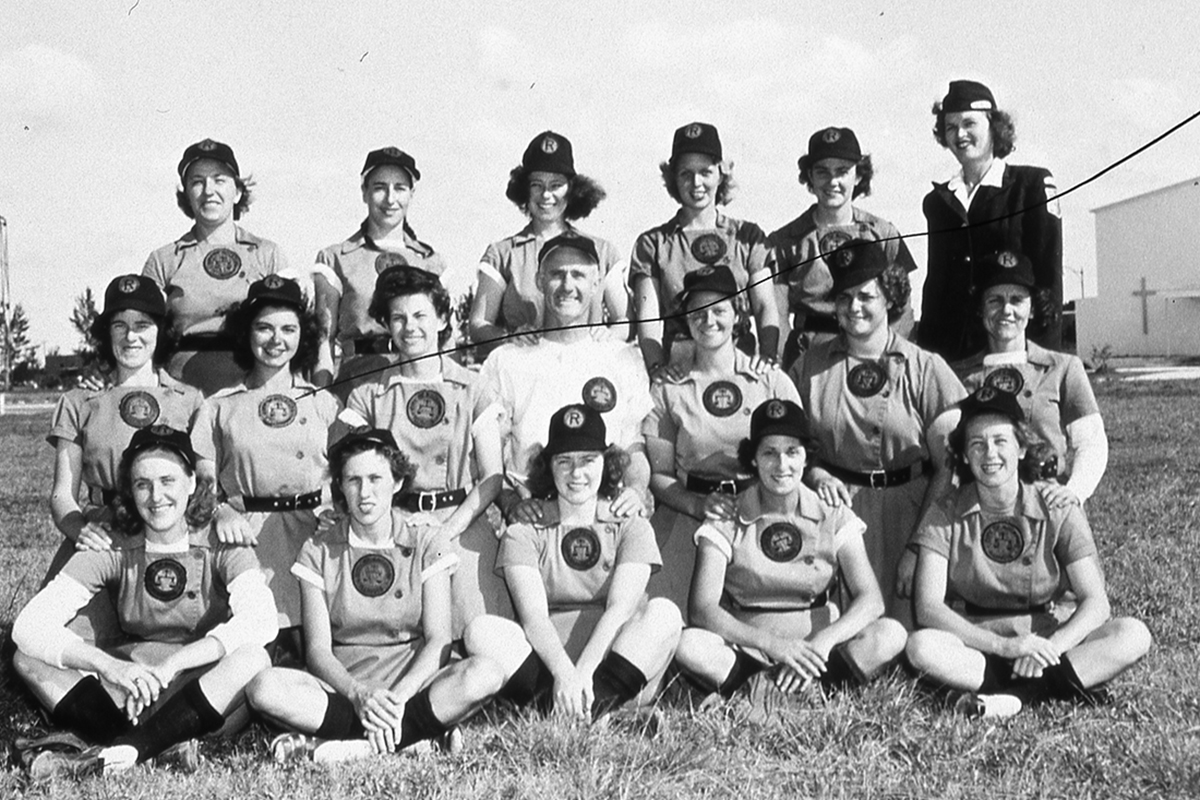
In addition to major-league baseball players, Dazzling Debuts: First At-Bat Home Runs is pleased to highlight players from other professional baseball leagues, including the All-American Girls Professional Baseball League (AAGPBL). Special thanks to Merrie Fidler, official historian of the AAGPBL Players Association, and Dr. Leslie Heaphy and Carol Sheldon, members of the SABR Women in Baseball Research Committee, for their research support and suggestions.
While we did not identify an AAGPBL player who hit a home run in her first at-bat, the research offered valuable insights into how modifications in playing equipment, pitch delivery, and diamond dimensions affected home-run production during the league’s 12 years in operation, from 1943 to 1954.
During the early years of the AAGPBL, the league was known to favor pitching over hitting. The baseball was 12 inches in circumference (like a softball), pitchers threw underhand (like in softball), and the distance to home plate was 40 feet (compared to the men’s leagues’ 60 feet 6 inches). Basepaths were also shorter.1 Along with strong pitching, the playing field rules typically resulted in team batting averages in the low .200s. Individual players rarely hit more than a few home runs in a season (if any), and team totals were typically less than 10.2
Seeking to appeal to a broader fan base, the league began making modifications to the game as early as 1944. The ball gradually became smaller, while the distances between bases and to home plate gradually increased. A major change came in 1948 when the league adopted overhand pitching. Ball size and distance adjustments continued until midseason 1954, when the playing field was nearly identical to the men’s game, and the use of a 9-inch baseball was adopted.3
The smaller baseball may be more challenging to hit, but when players connected, the ball traveled farther and faster. The statistics reflected this change. For example, in 1954, Joanne Weaver of the Fort Wayne Daisies led the league in home runs (29), hits (143), and batting average (.429), numbers that would have been unheard of a decade earlier.4
Fans and the press took notice of the offensive surge. The headline in the South Bend (Indiana) Tribune on July 2, 1954, read, “Smaller Ball Proves Boon to Bat Stars,” declaring the dawn of the home-run era for the AAGPBL and highlighting three home runs “smashed” at Playland Park, two of which were hit by Weaver.5
One can imagine that if the league had continued past 1954, recruiting more women directly into the more offense-conducive playing conditions, we could be writing about one or more first-at-bat home runs by AAGPBL players. However, we still celebrate the players who had the opportunity to showcase their hitting abilities in this league, especially during its later years.
Visit the AAGPBL Players Association website to learn more about this exciting time in American baseball history. SABR’s Women in Baseball Research Committee is another rich resource for the role of women in various aspects of professional baseball.
— Giselle Stancic
1944 Rockford Peaches (SABR-Rucker Archive)
Notes
1 “Rules of Play,” All-American Girls Professional Baseball League. https://www.aagpbl.org/history/rules-of-play, accessed June 22, 2024.
2 Traci L. Rucker, Reconciling Femininity and Athleticism: The All-American Girls Professional Baseball League, 1943-1954 (Indianapolis: ScholarWorks, 2004), 71. https://scholarworks.indianapolis.iu.edu/items/d162b1ac-bcd2-4476-a2d3-8abd4b6b98a3, accessed June 22, 2024.
3 Merrie A. Fidler, The Origins and History of the All-American Girls Professional Baseball League (Jefferson, North Carolina: McFarland, 2006), 71.
4 “Joanne Weaver,” All-American Girls Professional Baseball League. https://www.aagpbl.org/profiles/joanne-weaver-jo/623, accessed June 22, 2024.
5 “Smaller Ball Proves Boon to Bat Stars,” South Bend Tribune, July 2, 1954: Section 3, 1.


